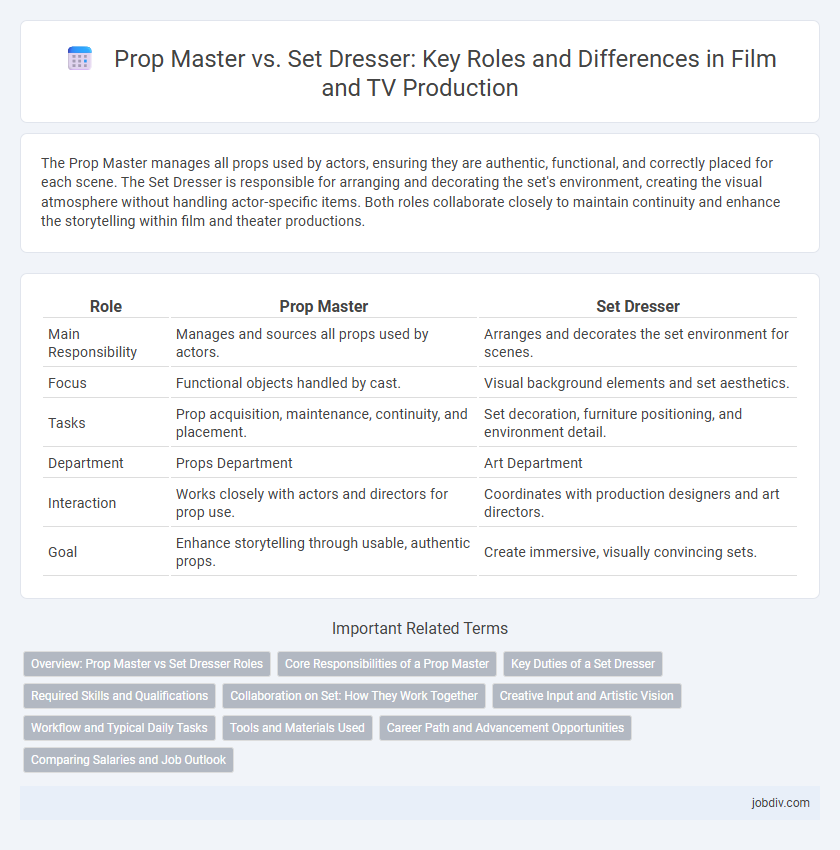The Prop Master manages all props used by actors, ensuring they are authentic, functional, and correctly placed for each scene. The Set Dresser is responsible for arranging and decorating the set's environment, creating the visual atmosphere without handling actor-specific items. Both roles collaborate closely to maintain continuity and enhance the storytelling within film and theater productions.
Table of Comparison
| Role | Prop Master | Set Dresser |
|---|---|---|
| Main Responsibility | Manages and sources all props used by actors. | Arranges and decorates the set environment for scenes. |
| Focus | Functional objects handled by cast. | Visual background elements and set aesthetics. |
| Tasks | Prop acquisition, maintenance, continuity, and placement. | Set decoration, furniture positioning, and environment detail. |
| Department | Props Department | Art Department |
| Interaction | Works closely with actors and directors for prop use. | Coordinates with production designers and art directors. |
| Goal | Enhance storytelling through usable, authentic props. | Create immersive, visually convincing sets. |
Overview: Prop Master vs Set Dresser Roles
A Prop Master manages and sources all the handheld items actors interact with to ensure authenticity and continuity during filming. A Set Dresser focuses on arranging and enhancing the physical environment on set, including furniture, wall hangings, and decorative elements that shape the scene's atmosphere. Both roles collaborate closely to create a cohesive and immersive visual narrative, but their responsibilities center on different aspects of the production design.
Core Responsibilities of a Prop Master
A Prop Master is responsible for sourcing, organizing, and maintaining all props used in a production to ensure continuity and authenticity. They collaborate with directors and set designers to select items that enhance the storytelling and meet the creative vision. Unlike set dressers, who arrange furniture and decor, Prop Masters focus specifically on functional objects actors interact with during scenes.
Key Duties of a Set Dresser
Set dressers are responsible for arranging and maintaining all the objects on a film or television set to create the desired atmosphere and ensure continuity. They meticulously place furniture, drapes, artwork, and small props, working closely with the production designer to enhance the visual storytelling. Their key duties also include adjusting set elements between scenes, repairing or replacing worn items, and ensuring the set reflects the script's time period and character details.
Required Skills and Qualifications
Prop masters require strong organizational skills, detailed knowledge of various materials, and the ability to source or create props that align with the director's vision. Set dressers must possess a keen eye for design, spatial awareness, and skills in arranging furniture and decorative items to enhance the authenticity and mood of a scene. Both roles demand collaboration, adaptability, and a solid understanding of film production processes.
Collaboration on Set: How They Work Together
Prop masters and set dressers collaborate closely on set to create a cohesive visual narrative, with prop masters managing functional objects actors interact with, while set dressers arrange background elements to enhance atmosphere. Their coordination ensures props and set decorations align with the director's vision and continuity requirements, avoiding conflicts or visual inconsistencies. Effective communication between these departments streamlines scene preparations, boosts on-set efficiency, and delivers a believable cinematic environment.
Creative Input and Artistic Vision
Prop Masters specialize in sourcing and managing objects that actors interact with, ensuring each item aligns with the director's vision and enhances storytelling. Set Dressers focus on arranging and styling the physical environment, creating an immersive atmosphere that supports the narrative's mood and time period. Both roles demand a keen artistic vision, but Prop Masters emphasize functional creativity, while Set Dressers prioritize visual composition and continuity.
Workflow and Typical Daily Tasks
Prop Masters oversee the acquisition, organization, and maintenance of all props required for a production, ensuring each item fits the director's vision and scene requirements. Set Dressers arrange and decorate the set environment with furniture, draperies, and smaller set pieces to create a believable atmosphere, closely collaborating with the art director to achieve the desired aesthetic. Daily tasks for Prop Masters include cataloging props, prepping and repairing items, while Set Dressers focus on staging, adjusting placements, and maintaining the set's visual continuity throughout filming.
Tools and Materials Used
Prop Masters primarily handle small, portable items like weapons, books, and personal accessories, using specialized tools such as glue guns, paintbrushes, and hand tools to modify or create props. Set Dressers focus on larger elements like furniture, draperies, and decorative objects, employing tools like measuring tapes, staple guns, and fabric cutters to arrange and secure set pieces. Both roles require a keen attention to detail and the ability to work with diverse materials including wood, foam, fabric, and metal to enhance the visual storytelling of a production.
Career Path and Advancement Opportunities
Prop Masters oversee the selection, acquisition, and management of all props used in a production, requiring strong organizational skills and a deep understanding of the script to ensure seamless storytelling. Set Dressers focus on arranging and maintaining the visual elements of a set, emphasizing aesthetic detail and collaboration with art directors to create an immersive environment. Career advancement for Prop Masters often leads to roles such as Props Supervisor or Art Director, while Set Dressers can progress to Lead Set Dresser or Set Decorator, with both paths offering opportunities in film, television, and theater production design departments.
Comparing Salaries and Job Outlook
Prop Masters typically earn an average salary ranging from $45,000 to $70,000 annually, while Set Dressers usually make between $35,000 and $60,000 per year, reflecting differences in responsibilities and industry demand. The job outlook for Prop Masters shows steady growth driven by increasing production budgets and the complexity of props needed in film and television, whereas Set Dressers face moderate growth influenced by shifts in set design trends and virtual production technologies. Both roles require specialized skills but Prop Masters often command higher pay due to their direct involvement with on-screen elements and prop maintenance during shoots.
Prop Master vs Set Dresser Infographic

 jobdiv.com
jobdiv.com